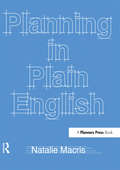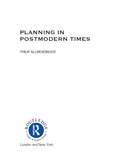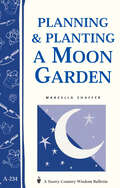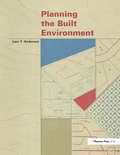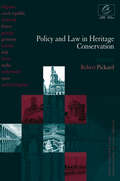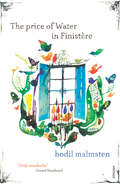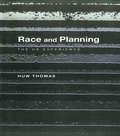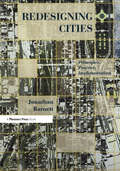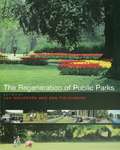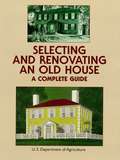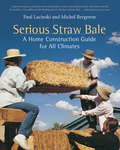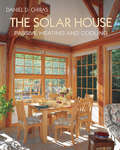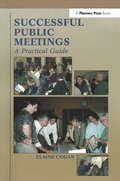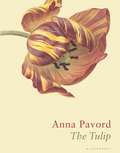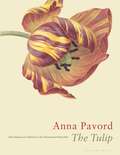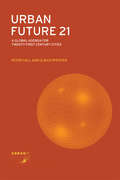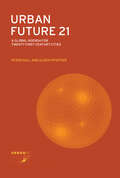- Table View
- List View
Planning in Plain English: Writing Tips for Urban and Environmental Planners
by Natalie MacrisIn this volume, the author draws from more than a decade of editing experience to explain how to craft clear, understandable, and highly readable planning documents. The author suggests ways to overcome planners' most common writing foibles: acronymns, jargon, and overuse of the passive voice. And the author provides handy lists to transform mushy nouns into powerful verbs, pare down bloated sentences, and translate ""bureaucratese"" into everyday language. The author even includes practice exercises designed to help you recognize and overcome bad writing habits. But even the best writing skills won't help if your document is organized poorly and aimed at the wrong audience.The author also explains why it's essential to know who your readers are before you start writing and how to organize your work so that it will be easy to understand and use."
Planning in Plain English: Writing Tips for Urban and Environmental Planners
by Natalie MacrisIn this volume, the author draws from more than a decade of editing experience to explain how to craft clear, understandable, and highly readable planning documents. The author suggests ways to overcome planners' most common writing foibles: acronymns, jargon, and overuse of the passive voice. And the author provides handy lists to transform mushy nouns into powerful verbs, pare down bloated sentences, and translate ""bureaucratese"" into everyday language. The author even includes practice exercises designed to help you recognize and overcome bad writing habits. But even the best writing skills won't help if your document is organized poorly and aimed at the wrong audience.The author also explains why it's essential to know who your readers are before you start writing and how to organize your work so that it will be easy to understand and use."
Planning in Postmodern Times (RTPI Library Series)
by Philip AllmendingerPostmodern social theory has provided significant insights into our understanding of society and its components. Key thinkers including Foucault, Baudrillard and Lyotard have challenged existing ideas about power and rationality in society. This book analyses planning from a postmodern perspective and explores alternative conceptions based on a combination of postmodern thinking and other fields of social theory. In doing so, it exposes some of the limits of postmodern social theory while providing an alternative conception of planning in the twenty-first century.This title will appeal to anyone interested in how we think and act in relation to cities, urban planning and governance.
Planning in Postmodern Times (RTPI Library Series)
by Philip AllmendingerPostmodern social theory has provided significant insights into our understanding of society and its components. Key thinkers including Foucault, Baudrillard and Lyotard have challenged existing ideas about power and rationality in society. This book analyses planning from a postmodern perspective and explores alternative conceptions based on a combination of postmodern thinking and other fields of social theory. In doing so, it exposes some of the limits of postmodern social theory while providing an alternative conception of planning in the twenty-first century.This title will appeal to anyone interested in how we think and act in relation to cities, urban planning and governance.
Planning & Planting a Moon Garden: Storey's Country Wisdom Bulletin A-234 (Storey Country Wisdom Bulletin)
by Marcella ShafferWith today's schedules, few people are able to enjoy their gardens during prime daylight hours. But there is a way you can delight in the fragrance and beauty of flowers after dark: Plant a night-blooming garden! Also known as moon gardens, night-blooming gardens are expressly designed for evening enjoyment. While attractive during the day, they take on a whole new look and feel at dusk, casting a magical spell. Pale-colored flowers reflect light from the setting sun and the rising moon, shining luminously and giving the garden an almost mystical glow. Fragrances seem more alluring. Silvery foliage shimmers tremulously as the evening breezes dance by. An aromatic, night-blooming garden offers a peaceful and tranquil spot to rest and relax at the end of the day. It is the perfect place for a casual summer party, an evening reception, a romantic tryst, or a quiet retreat to reflect and rejuvenate the senses.
Planning the Built Environment
by Larz AndersonPlanning the Built Environment takes a systematic, technical approach to describing how urban infrastructures work. Accompanied by detailed diagrams, illustrations, tables, and reference lists, the book begins with landforms and progresses to essential utilities that manage drainage, wastewater, power, and water supply. A section on streets, highways, and transit systems is highly detailed and practical. Once firmly grounded in these "macro" systems, Planning the Built Environment examines the physical environments of cities and suburbs, including a discussion of critical elements such as street and subdivision planning, density, and siting of community facilities. Each chapter includes essential definitions, illustrations and diagrams, and an annotated list of references. This timely book explains new physical planning methods and current thinking on cluster development, new urbanism, and innovative transit planning and development. Planners, architects, engineers, and anyone who designs or manages the physical components of urban areas will find this book both an authoritative reference and an exhaustive, understandable technical manual of facts and best practices. Instructors in planning and allied fields will appreciate the practical exercises that conclude each chapter: valuable learning tools for students and professionals alike.
Planning the Built Environment
by Larz AndersonPlanning the Built Environment takes a systematic, technical approach to describing how urban infrastructures work. Accompanied by detailed diagrams, illustrations, tables, and reference lists, the book begins with landforms and progresses to essential utilities that manage drainage, wastewater, power, and water supply. A section on streets, highways, and transit systems is highly detailed and practical. Once firmly grounded in these "macro" systems, Planning the Built Environment examines the physical environments of cities and suburbs, including a discussion of critical elements such as street and subdivision planning, density, and siting of community facilities. Each chapter includes essential definitions, illustrations and diagrams, and an annotated list of references. This timely book explains new physical planning methods and current thinking on cluster development, new urbanism, and innovative transit planning and development. Planners, architects, engineers, and anyone who designs or manages the physical components of urban areas will find this book both an authoritative reference and an exhaustive, understandable technical manual of facts and best practices. Instructors in planning and allied fields will appreciate the practical exercises that conclude each chapter: valuable learning tools for students and professionals alike.
Policy and Law in Heritage Conservation
by Robert PickardThis book has been developed in association with the Cultural Heritage Department of the Council of Europe. It examines key themes and objectives for the protection of the architectural and archaeological heritage in a range of European countries. The analysis of individual countries and the group as a whole gives an assessment of how advanced current mechanisms are and the ongoing problems that remain to be managed in order to safeguard the 'common heritage'.
Policy and Law in Heritage Conservation (Conservation Of The European Built Heritage Ser.)
by Robert PickardThis book has been developed in association with the Cultural Heritage Department of the Council of Europe. It examines key themes and objectives for the protection of the architectural and archaeological heritage in a range of European countries. The analysis of individual countries and the group as a whole gives an assessment of how advanced current mechanisms are and the ongoing problems that remain to be managed in order to safeguard the 'common heritage'.
The Price Of Water In Finistère
by Bodil Malmsten'In the same way as there's a partner for every person, there's a place. All you have to do is find the one that's yours among the billions that belong to someone else, you have to be awake, you have to choose.' With this conviction in mind, acclaimed Swedish writer Bodil Malmsten abandons her native country at the age of fifty-five and settles in Brittany. At the heart of this memoir is the conviction that the happiness to be found in Finistère will not allow itself to be, cannot be, expressed in writing. Embroidered around this seeming paradox are poignant, outraged and thought-provoking observations on the widest range of subjects: how not to buy plants, the elicit pleasures of bargain-hunting, the misery of writer's block, social democracy, racism, tulipomania, the stubbornness of bank managers, the controlling of moles and slugs, death, political hypocrisy, the delights of wild weather. Malmsten's passion and humour shine through every episode she describes, however minor, offering the reader a window onto a solitary life at once touching, thought-provoking and, occasionally, hilarious.
Race and Planning: The UK Experience
by Huw ThomasDrawing on a number of research studies of planning and urban policy, ace and Planning asks why racial equality has not been higher on professional and government agendas, and suggests strategies for those working on change. It considers key issues such as how planning activities might lead to more emphasis on the significance of racial equality; might currently it be unwittingly underpinning racial disadvantage? Alternatively, can planning help challenge racism and promote equal opportunities? The book's arguments are sensitive to the rapidly changing focus of the politics of race including: 'fortress Europe', Macpherson and modernism.
Race and Planning: The UK Experience
by Huw ThomasDrawing on a number of research studies of planning and urban policy, ace and Planning asks why racial equality has not been higher on professional and government agendas, and suggests strategies for those working on change. It considers key issues such as how planning activities might lead to more emphasis on the significance of racial equality; might currently it be unwittingly underpinning racial disadvantage? Alternatively, can planning help challenge racism and promote equal opportunities? The book's arguments are sensitive to the rapidly changing focus of the politics of race including: 'fortress Europe', Macpherson and modernism.
Redesigning Cities: Principles, Practice, Implementation
by Jonathan BarnettThis book is recommended reading for planners preparing to take the AICP exam. Too often, no one is happy with new development: Public officials must choose among unappealing alternatives, developers are frustrated and the public is angry. But growing political support for urban design, developers' interest in community building and successful examples of redesigned cities all over the U.S. are hopeful signs of change. The author explains how design can reshape suburban growth patterns, revitalize older cities, and retrofit metropolitan areas where earlier development decisions went wrong. The author describes in detail specific techniques, materials, and technologies that should be known (but often aren't) to planners, public officials, concerned citizens, and others involved in development.
Redesigning Cities: Principles, Practice, Implementation
by Jonathan BarnettThis book is recommended reading for planners preparing to take the AICP exam. Too often, no one is happy with new development: Public officials must choose among unappealing alternatives, developers are frustrated and the public is angry. But growing political support for urban design, developers' interest in community building and successful examples of redesigned cities all over the U.S. are hopeful signs of change. The author explains how design can reshape suburban growth patterns, revitalize older cities, and retrofit metropolitan areas where earlier development decisions went wrong. The author describes in detail specific techniques, materials, and technologies that should be known (but often aren't) to planners, public officials, concerned citizens, and others involved in development.
The Regeneration of Public Parks
by Ken Fieldhouse Jan WoudstraThe Urban Parks Programme, financed by the Heritage Lottery Fund, has sparked a new enthusiasm for the regeneration of Britain's parks. This unique reference book gives a valuable overview of all the elements of public park design. It emphasizes our parks' diversity and richness, and offers practical guidance as to their renovation and future care. It is essential reading for all those involved in the design, upkeep and regeneration of public parks.
The Regeneration of Public Parks
by Jan Woudstra Ken FieldhouseThe Urban Parks Programme, financed by the Heritage Lottery Fund, has sparked a new enthusiasm for the regeneration of Britain's parks. This unique reference book gives a valuable overview of all the elements of public park design. It emphasizes our parks' diversity and richness, and offers practical guidance as to their renovation and future care. It is essential reading for all those involved in the design, upkeep and regeneration of public parks.
Selecting and Renovating an Old House: A Complete Guide
by U.S. Dept. of AgricultureClear, thoughtfully written manual tells how to appraise worthiness of an older home, develop plans for remodeling the kitchen, adding a bath, replacing floors, roof, windows, doors, interior walls, kitchen cabinets, and much more. Full glossary of housing terms and 157 illustrations clarify an extremely detailed text.
Serious Straw Bale: A Home Construction Guide for All Climates
by Paul Lacinski Michel BergeronIn 1994, when Chelsea Green published The Straw Bale House, the response from many people was a loud, "Huh?!" Those days are gone. With more than 100,000 copies sold, and straw bale projects underway in most regions of North America, we've entered a new era. Even building-code officials and insurance companies now look favorably upon straw bale buildings, with their extraordinary energy efficiency and wise use of agricultural waste for construction materials. Bergeron and Lacinski's new book Serious Straw Bale is the first to look carefully at the specific design considerations critical to success with a straw bale building in more extreme climates-where seasonal changes in temperature, precipitation, and humidity create special stresses that builders must understand and address. The authors draw upon years of experience with natural materials and experimental techniques, and present a compelling rationale for building with straw-one of nature's most resilient, available, and affordable byproducts. For skeptics and true believers, this book will prove to be the latest word. Thorough explanations of how moisture and temperature affect buildings in seasonal climates, with descriptions of the unique capacities of straw and other natural materials to provide warmth, quiet, and comfort year-round. Comprehensive comparison of the two main approaches to straw bale construction: "Nebraska-style," where bales bear the weight of the roof, and framed structures, where bales provide insulation. Detailed advice-including many well-considered cautions-for contractors, owner-builders, and designers, following each stage of a bale-building process. This is a second-generation straw bale book, for those seeking serious information to meet serious challenges while adventuring in the most fun form of construction to come along in several centuries.
The Solar House: Passive Heating and Cooling (Real Goods Solar Living Bks.)
by Daniel D. ChirasPassive solar heating and passive cooling—approaches known as natural conditioning—provide comfort throughout the year by reducing, or eliminating, the need for fossil fuel. Yet while heat from sunlight and ventilation from breezes is free for the taking, few modern architects or builders really understand the principles involved. Now Dan Chiras, author of the popular book The Natural House, brings those principles up to date for a new generation of solar enthusiasts. The techniques required to heat and cool a building passively have been used for thousands of years. Early societies such as the Native American Anasazis and the ancient Greeks perfected designs that effectively exploited these natural processes. The Greeks considered anyone who didn't use passive solar to heat a home to be a barbarian! In the United States, passive solar architecture experienced a major resurgence of interest in the 1970s in response to crippling oil embargoes. With grand enthusiasm but with scant knowledge (and sometimes little common sense), architects and builders created a wide variety of solar homes. Some worked pretty well, but looked more like laboratories than houses. Others performed poorly, overheating in the summer because of excessive or misplaced windows and skylights, and growing chilly in the colder months because of insufficient thermal mass and insulation and poor siting. In The Solar House, Dan Chiras sets the record straight on the vast potential for passive heating and cooling. Acknowledging the good intentions of misguided solar designers in the past, he highlights certain egregious—and entirely avoidable—errors. More importantly, Chiras explains in methodical detail how today's home builders can succeed with solar designs. Now that energy efficiency measures including higher levels of insulation and multi-layered glazing have become standard, it is easier than ever before to create a comfortable and affordable passive solar house that will provide year-round comfort in any climate. Moreover, since modern building materials and airtight construction methods sometimes result in air-quality and even toxicity problems, Chiras explains state-of-the-art ventilation and filtering techniques that complement the ancient solar strategies of thermal mass and daylighting. Chiras also explains the new diagnostic aids available in printed worksheet or software formats, allowing readers to generate their own design schemes.
Successful Public Meetings, 2nd ed.: A Practical Guide
by Elaine CoganThe author explains why it's essential to begin the preparations by deciding what the meeting is intended to accomplish. That, in turn, determines what kind of meeting you should conduct: informational, advisory, or problem-solving. The author breaks down the essential tasks involved and even suggests the right type of person to handle each one. She describes various types of troublesome meeting attendees-from accusers and apathetics to fence-sitters and know-it-alls-and offers advice on how to deal tactfully but firmly with them all. The author also tackles working effectively with the media, a subject that terrifies most planners. True stories of public meetings, both good and bad, add humor to her no-nonsense narrative. Follow her step-by-step checklist and leave nothing to chance."
Successful Public Meetings, 2nd ed.: A Practical Guide (Jossey-bass Public Administration Ser.)
by Elaine CoganThe author explains why it's essential to begin the preparations by deciding what the meeting is intended to accomplish. That, in turn, determines what kind of meeting you should conduct: informational, advisory, or problem-solving. The author breaks down the essential tasks involved and even suggests the right type of person to handle each one. She describes various types of troublesome meeting attendees-from accusers and apathetics to fence-sitters and know-it-alls-and offers advice on how to deal tactfully but firmly with them all. The author also tackles working effectively with the media, a subject that terrifies most planners. True stories of public meetings, both good and bad, add humor to her no-nonsense narrative. Follow her step-by-step checklist and leave nothing to chance."
The Tulip: The Story of the Flower that Has Made Men Mad
by Anna PavordAnna Pavord's now classic, internationally bestselling sensation, The Tulip, is not a gardening book. It is the story of a flower that has driven men mad. Greed, desire, anguish and devotion have all played their part in the development of the tulip from a wild flower of the Asian steppes to the worldwide phenomenon it is today. No other flower carries so much baggage; it charts political upheavals, illuminates social behaviour, mirrors economic booms and busts, plots the ebb and flow of religious persecution.
The Tulip: Twentieth Anniversary Edition
by Anna PavordA twentieth anniversary edition of the classic, featuring new material by the author. Anna Pavord's internationally bestselling sensation, The Tulip, is the story of a flower that has driven men mad. Greed, desire, anguish, and devotion have all played their part in the development of the tulip into a worldwide phenomenon. Today, the United States alone imports three thousand million tulip bulbs each year. No other flower has ever carried so much consequence; it charts political upheavals, illuminates social behavior, mirrors economic booms and busts, plots the ebb and flow of religious persecution. Why did the tulip dominate so many lives through so many centuries in so many countries? Anna Pavord, a self-confessed tulipomaniac, spent six years looking for answers, roaming through Asia, India, and the Ottoman Empire to tell how a humble wildflower of the Asian steppes made its way to Turkey and from there took the whole of Western Europe by storm. Sumptuously illustrated from a wide range of sources, this irresistible volume has become a bible, a unique source book, a universal gift book, and a joy to all who possess it. This beautifully redesigned edition features a new Preface by the author, a completely revised listing of the best varieties of this incomparable flower to choose for your garden, and a reorganized listing of tulip species, to reflect the latest thinking by taxonomists.
Urban Future 21: A Global Agenda for Twenty-First Century Cities
by Peter Hall Ulrich PfeifferPrepared for the World Commission on Twenty-First Century Urbanization Conference in Berlin in July 2000. This book is an entirely new and comprehensive review of the state of world urban development at the millennium and a forecast of the main issues that will dominate urban debates in the next 25 years. It is the most significant book on cities and city planning problems to appear for many years.
Urban Future 21: A Global Agenda for Twenty-First Century Cities
by Peter Hall Ulrich PfeifferPrepared for the World Commission on Twenty-First Century Urbanization Conference in Berlin in July 2000. This book is an entirely new and comprehensive review of the state of world urban development at the millennium and a forecast of the main issues that will dominate urban debates in the next 25 years. It is the most significant book on cities and city planning problems to appear for many years.
